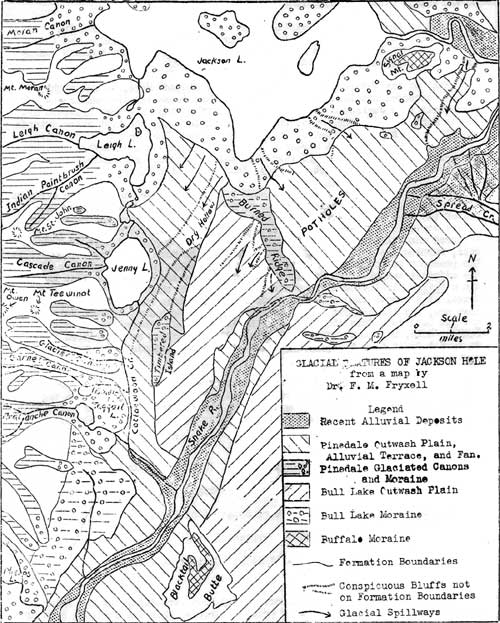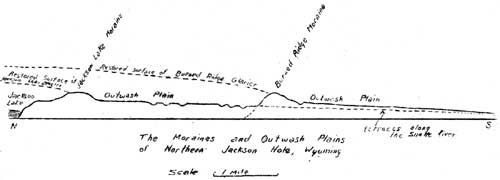|
GRAND TETON NATURE NOTES
|
| Vol. III |
Winter 1937 |
No. 1. |
|
TETON GEOLOGICAL NOTES - No. 1
THE GLACIATION OF JACKSON HOLE
by Dr. F. M. Fryxell
The geological record from which one may decipher the glacial history
of the Teton Range is found in part within the mountains themselves, in
part outside them, especially in adjacent Jackson Hole.
To many visitors, speeding up the state highway, the flats of Jackson
Hole may seem to offer little that is worth a second glance. But the
geologist will recognize on the valley floor a great diversity of
ridges, terraces, channels, and depressions, features that furnish the
key to the glacial events which have occurred both in the valley and in
the great range to the west.
To grasp the significance of these features one can do no better than
visit the east tip of the main section of Burned Ridge (see map, page
3), and from this point, with the Narrows of the Snake River directly
below, survey the country to the north and south.

(click on image for a PDF version)
Here one sees that Jackson Hole is diagonally crossed by two low,
wooded ridges: Burned Ridge on which we stand, and another ridge several
miles to the north, that follows the south border of Jackson Lake.
Around this northerly ridge the Snake River makes a circuitous eastward
journey whence it turns southwestward and directly through Burned Ridge
to form the Narrows at our feet. Were we to examine more closely, we
would discover that both of these ridges are irregular and hummocky of
surface, and composed of cobbles and boulders many of which are striated
— proof that they were transported by glaciers, and that therefore
the ridges themselves are typical glacial moraines.
Equally distinct from our viewpoint are two broad plains which extend
outward from these ridges and slope evenly southward. Unlike the ridges
from which they emerge, these plains are overgrown with sagebrush; hence
the moraines and the glacial outwash plains — for such they are
— are strikingly distinct. Composed of porous quartzite gravel with
little or no soil they constitute barren ground indeed for anything but
sage. Both of the outwash plains are deeply trenched by the Snake River,
and the northerly plain is continued south of the Narrows by terraces
that border the Snake River well beyond Blacktail Butte, where they
widen into the swampy flats of the southern part of Jackson Hole.
The meaning of these features now becomes evident, for they can mean
only this: that northern Jackson Hole was at two distinct times
invaded by a glacier. These two times of glaciation must correspond to
those which geologists have reported from the Wind River Mountains and
elsewhere, on the basis of similar records there found. For the earlier
of these times the term "Bull Lake Stage" is generally used; for the
latter, "Pinedale Stage". In terms of these stages then, one may briefly
review the glacial events of this region:
In the Bull Lake Stage a glacier (The Burned Ridge Glacier) entered
the valley from the north and northwest, and advanced as far as Burned
Ridge. At this position it must have stood for a time long enough to
permit the ice to heap up the Burned Ridge moraine, and the glacial
streams to deposit the outwash plain extending southward from it. The
plain must have reached unbrokenly around and beyond Blacktail Butte,
into the most southerly reaches of Jackson Hole.
In time the Burned Ridge Glacier melted back from its moraine, and
eventually disappeared altogether. Did a large lake come into existence
in the basin behind Burned Ridge? If so (as seems probable) it must have
been drained during the interglacial stage which followed — an
interval of long duration in the course of which streams greatly reduced
the extent of Burned Ridge, trenched the outwash plain between the
Narrows and Blacktail Butte, and in southern Jackson Hole largely eroded
away similar Bull Lake deposits.
The task of the streams was arrested unfinished, when in Pinedale
time glacial conditions returned. Again a glacier (the "Jackson Lake
Glacier") pushed into the north end of the valley, fed chiefly by
smaller glaciers which occupied the Teton canons. In its southward
growth it advanced over the same path as its predecessor of the Bull
Lake Stage. The moraine of this glacier indicates that its front must
have shifted back and forth. The large size of the Jackson Lake moraine
is evidence of a prolonged stand in this position, but there are
"islands" of moraine farther south, protruding from the outwash plain.
That the ice front got farther south than even these "islands" is
indicated by the pitted areas (locally called "the potholes") which lie
between them and Burned Ridge. Presumably these pits mark situations
where the glacier, in retreating, left behind it masses of stagnant ice
which had separated from its main body. These ice masses became
surrounded or buried by outwash gravels, which, when the ice later
melted out, slumped in to produce depressions in the otherwise even
outwash plain. Since pits of this sort extend all the way to Burned
Ridge, one is led to conclude that the Jackson Lake Glacier for at least
a brief time reached as far south as this ridge, that is, it practically
attained the same limits as did the Burned Ridge Glacier long
before.
From this shifting ice front vast quantities of outwash gravel were
carried out by short-lived glacial streams. These were deposited not
only on the main outwash plain but within the river trench south of the
Narrows and on the valley floor in southern Jackson Hole.
Jackson Lake came into existence as the glacier retreated from the
Jackson Lake Moraine, and the water was dammed between the moraine and
the ice front. With the complete disappearance of the ice the lake
assumed essentially its present size and shape.
What of the Tetons during the two glacial stages? Here, as one might
expect occurred similar events. Valley glaciers descended the canons and
pushed out into Jackson Hole. The moraines left by the Bull Lake
glaciers are now in most places eroded away, but Timbered Island and the
high bench extending along the mountain front southward from Taggart
Lake appear to be extensive remnants of Bull Lake moraine. The Pinedale
moraines, in marked contrast, are beautifully preserved, and form the
basins which are responsible for the existence of Phelps, Taggart,
Bradley, Jenny and Leigh Lakes.
But the glacial story can be pushed back yet another chapter. For
evidence of this one must climb to the summits of Signal Mountain,
Blacktail Butte, or one of the Gros Ventre Buttes. In these surprising
situations one again discovers striated boulders and cobbles — mere
patches of ancient moraine, like tattered manuscripts. Similar deposits
occur on the highlands east of Jackson Hole, capping the intercanyon
divides 1000 feet or more above the valley floor. The presence of
morainal remnants in such situations, and their absence in the adjacent
canyons, can be accounted for only by the assumption that there was a
third glaciation which occurred much earlier than even the Bull Lake
Stage, at a remote time when the floor of Jackson Hole was 1000 feet
higher than now, and the present system of canyons which open into
Jackson Hole had not yet been cut. This stage, which likewise has been
recognized far outside Jackson Hole, has been named the "Buffalo Stage".
Scanty as its record is we cannot doubt that this, the earliest of the
three glaciations, was much the most widespread.
Thus, what we commonly call the "Ice Age" or "Glacial Period" (the
"Pleistocene Period" in geological terminology), which lasted perhaps
two million years, really involved no less than three distinct times of
glaciation, and two of deglaciation. These may be tabularly represented
as follows:
Postglacial time
Subdivisions
of the
Pleistocene
Period |
|
( Pinedale Glacial Stage (3rd glaciation) |
| ( |
| ( Later Interglacial Stage |
| ( |
| ( Bull Lake Glacial Stage (2nd glaciation) |
| ( |
| ( Earlier Interglacial Stage |
| ( |
| ( Buffalo Glacial Stage (1st glaciation) |
Preglacial time
The three glaciations were successively less extensive, and the later
of the two interglacial stages was of briefer duration than the earlier.
What of postglacial time, which represents the briefest interval of all?
Is it truly postglacial, or are we now living in a third interglacial
stage? To this question geology has as yet no positive answer, though
investigation now in progress leads one to hope that a future solution
is not improbable.

(click on image for a PDF version)
| 
